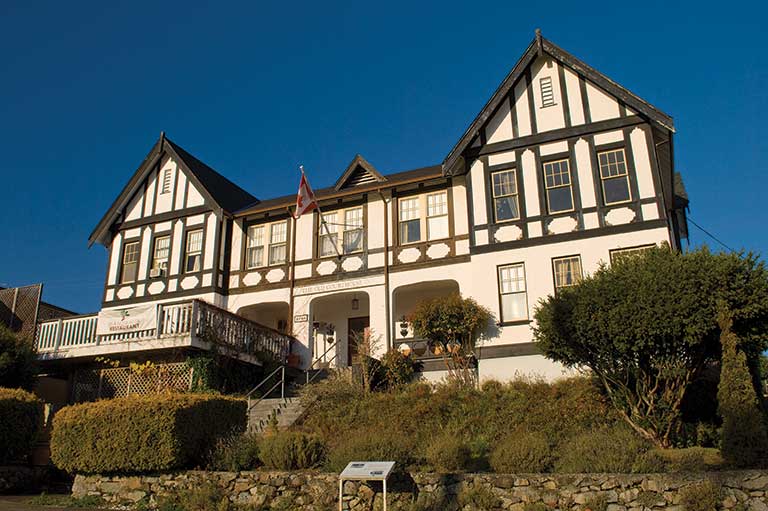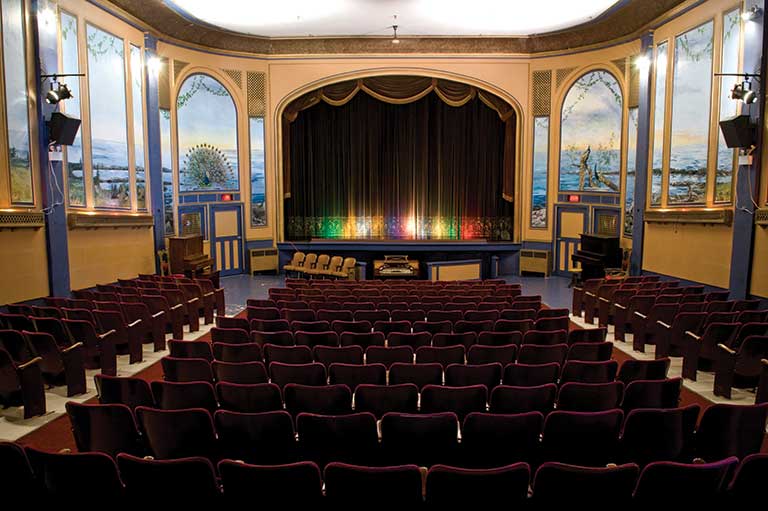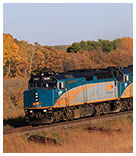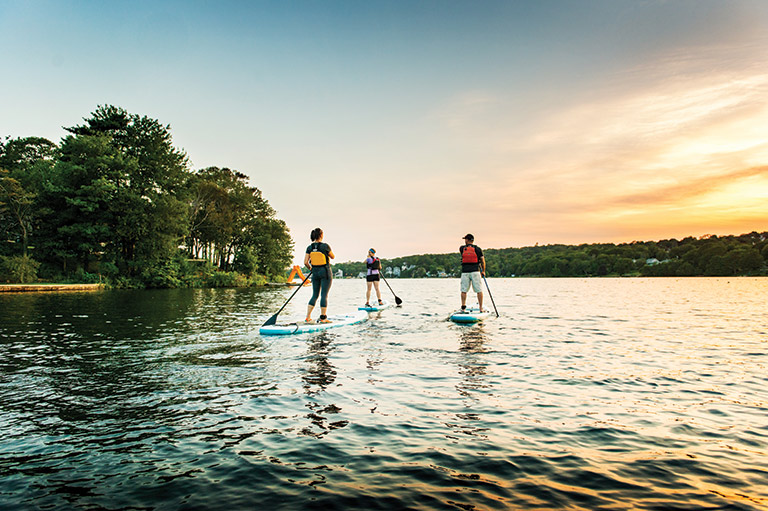Charming Company Town

On first impression, the city of Powell River on British Columbia’s Sunshine Coast seems more industrial than historic. Split into two parts separated by a patch of temperate rainforest, the city’s older more northerly section is dominated by a red-and-white-striped smokestack discharging plumes of wispy vapour and a floating breakwater comprised of ten mildewed concrete ships.
The smokestack belongs to the Powell River paper mill, once the largest producer of newsprint in the world. The ships are leftover storage craft from the Second World War; aside from protecting the harbour, they provide a winter refuge for herds of sea lions.
Powell River’s tight grid of residential buildings is handsome, well-preserved, and remarkably homogeneous. This is the Powell River Historic Townsite District, which in 1995 was designated a National Historic Site as an exceptional example of a planned company town dating from the early years of the twentieth century.
It is estimated that ninety-seven per cent of the area’s surviving buildings are more than ninety years old. A resident from the 1920s could quite happily drive through here in a Model T Ford and, aside from the odd cellphone-brandishing teenager, barely know that it’s now the twenty-first century.
Like many visitors, I first came to Powell River to experience the outdoors rather than the history. Clinging to the Sunshine Coast 170 kilometres and two ferry rides north of Vancouver, the town is a locus for sea kayaking, mountain biking, and hiking on Canada’s longest hut-to-hut trail.
This tract of British Columbia’s coast has been inhabited by the Tla’amin Nation since time immemorial. Their village of Tees Kwat once sat at the mouth of the Powell River, before the waterway was controversially dammed in 1910 to serve the paper mill. The Tla’amin were forced to move north to the village of Sliammon. The Powell River Historical Museum provides more background to the Tla’amin story as well as exhibits about the town’s more recent industrial past.
With my sights set on speed-hiking a fifty-kilometre section of the Sunshine Coast Trail, I bypassed the museum on my initial drive through the city and headed directly into the backcountry. My introduction to the historic townsite came a day later while recuperating in the Old Courthouse Inn, the town’s former police station and jail. These days the former courthouse is a comfortable hotel preserved at its 1930s high-water mark with an attractive mock-Tudor facade and an interior stuffed with patterned carpets and antique furniture.

Peeping out my window through the thick drapes brought me face to face with the giant paper mill, an iron skeleton of chutes, chimneys, and industrial architecture. Completed in 1912, the factory once provided work for more than 2,500 people.
A purpose-built town quickly grew around it, and, within a few years, the surrounding streets were embellished with churches, a cinema, a dance hall, a hotel, a post office, a bank, and scores of detached wooden houses with small gardens, most of them designed in the Arts and Crafts style that was in vogue at the time.
Powell River was developed on the principles of the garden city movement, pioneered in the United Kingdom in the early 1900s, with planned urban amenities juxtaposed with a leafy greenbelt. When the town started to grow beyond the confines of the mill after the Second World War, authorities refrained from adding strip malls and suburban sprawl and instead built a newer version of Powell River several kilometres to the south — a neighbourhood known today as Westview.
The original town has stayed much as it was in the 1920s, with a few minor updates. Besides the courthouse now being a hotel, two churches have been deconsecrated and made into apartments, and the former post office has been converted into a microbrewery.

Shirking modernization, the original theatre, the Patricia, is still in operation and professes to be the oldest continuously running cinema in British Columbia. The paper mill also remains, although its workforce now numbers in the hundreds.
To appreciate Powell River’s unique layout and design, I decided to take a stroll around the old townsite, fuelling up first at Edie Rae’s Café in the Old Courthouse Inn before hitting the small commercial district abutting the mill where signboards explain the history of the key buildings. Intrigued, I absorbed the back stories of Dr. Henderson’s house, the town’s original hospital; Dwight Hall, a dance venue where the 1920s truly roared; and the Rodmay Hotel, the oldest commercial building, constructed in 1911.
A short climb up a hill brought me to the residential district, where attractive houses with chimneys and porches dominate Management Row on Marine Avenue, the erstwhile domain of the factory’s top brass.
From a lookout on the avenue, I veered back down the hillside to the Willingdon BeachTrail,a forested walkway along a former logging railway that catalogues Powell River’s lumber history. Heavy machines, including a steam donkey (steam-powered winch), punctuate the path, their rusty hulks looking unexpectedly at home in the dense woodland.
Guided back to the townsite by the sound of barking sea lions, I emerged next to the timber-framed Dwight Hall. It was Sunday morning, and the streets were eerily empty. Closing my eyes for a second, I tried to imagine the rumble of mill workers’ boots and the sound of a piano emanating from the old dance hall nearly a century ago.
IF YOU GO

GETTING THERE: Powell River is a four-and-a-quarter-hour drive from Vancouver, including ferry crossings at Horseshoe Bay and Earl’s Cove. A private bus, the Sunshine Coast Connector, runs up the coast from May to September.
WHERE TO STAY: The Rodmay Heritage Hotel and the Old Courthouse Inn are located in the city’s historic townsite. Breakfast is served six days a week at the latter’s Edie Rae’s Café, which is closed on Mondays.
EXPLORE: The Townsite Heritage Society offers summer walking tours for ten dollars per person. The Powell River Historical Museum showcases artifacts of the Tla’amin Nation as well as exhibits about homesteading, logging, the pulp and paper mill, and the region’s marine life.
DRINK: Townsite Brewing is an excellent craft brewery located in the historic townsite and includes a tasting room. Try the Tin Hat IPA.
Themes associated with this article
Advertisement
You might also like...

Canada’s History and its partners offer unique, history-based tours at home and abroad throughout the year.
Help support history teachers across Canada!
By donating your unused Aeroplan points to Canada’s History Society, you help us provide teachers with crucial resources by offsetting the cost of running our education and awards programs.









